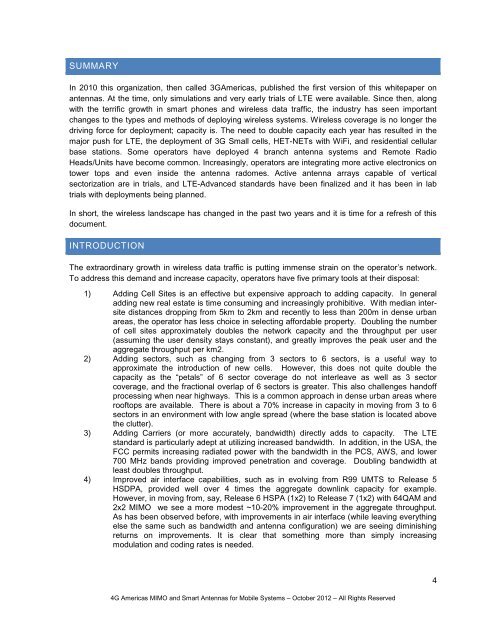MIMO and Smart Antennas for Mobile Broadband ... - 4G Americas
MIMO and Smart Antennas for Mobile Broadband ... - 4G Americas
MIMO and Smart Antennas for Mobile Broadband ... - 4G Americas
Create successful ePaper yourself
Turn your PDF publications into a flip-book with our unique Google optimized e-Paper software.
SUMMARYIn 2010 this organization, then called 3G<strong>Americas</strong>, published the first version of this whitepaper onantennas. At the time, only simulations <strong>and</strong> very early trials of LTE were available. Since then, alongwith the terrific growth in smart phones <strong>and</strong> wireless data traffic, the industry has seen importantchanges to the types <strong>and</strong> methods of deploying wireless systems. Wireless coverage is no longer thedriving <strong>for</strong>ce <strong>for</strong> deployment; capacity is. The need to double capacity each year has resulted in themajor push <strong>for</strong> LTE, the deployment of 3G Small cells, HET-NETs with WiFi, <strong>and</strong> residential cellularbase stations. Some operators have deployed 4 branch antenna systems <strong>and</strong> Remote RadioHeads/Units have become common. Increasingly, operators are integrating more active electronics ontower tops <strong>and</strong> even inside the antenna radomes. Active antenna arrays capable of verticalsectorization are in trials, <strong>and</strong> LTE-Advanced st<strong>and</strong>ards have been finalized <strong>and</strong> it has been in labtrials with deployments being planned.In short, the wireless l<strong>and</strong>scape has changed in the past two years <strong>and</strong> it is time <strong>for</strong> a refresh of thisdocument.INTRODUCTIONThe extraordinary growth in wireless data traffic is putting immense strain on the operator’s network.To address this dem<strong>and</strong> <strong>and</strong> increase capacity, operators have five primary tools at their disposal:1) Adding Cell Sites is an effective but expensive approach to adding capacity. In generaladding new real estate is time consuming <strong>and</strong> increasingly prohibitive. With median intersitedistances dropping from 5km to 2km <strong>and</strong> recently to less than 200m in dense urbanareas, the operator has less choice in selecting af<strong>for</strong>dable property. Doubling the numberof cell sites approximately doubles the network capacity <strong>and</strong> the throughput per user(assuming the user density stays constant), <strong>and</strong> greatly improves the peak user <strong>and</strong> theaggregate throughput per km2.2) Adding sectors, such as changing from 3 sectors to 6 sectors, is a useful way toapproximate the introduction of new cells. However, this does not quite double thecapacity as the “petals” of 6 sector coverage do not interleave as well as 3 sectorcoverage, <strong>and</strong> the fractional overlap of 6 sectors is greater. This also challenges h<strong>and</strong>offprocessing when near highways. This is a common approach in dense urban areas whererooftops are available. There is about a 70% increase in capacity in moving from 3 to 6sectors in an environment with low angle spread (where the base station is located abovethe clutter).3) Adding Carriers (or more accurately, b<strong>and</strong>width) directly adds to capacity. The LTEst<strong>and</strong>ard is particularly adept at utilizing increased b<strong>and</strong>width. In addition, in the USA, theFCC permits increasing radiated power with the b<strong>and</strong>width in the PCS, AWS, <strong>and</strong> lower700 MHz b<strong>and</strong>s providing improved penetration <strong>and</strong> coverage. Doubling b<strong>and</strong>width atleast doubles throughput.4) Improved air interface capabilities, such as in evolving from R99 UMTS to Release 5HSDPA, provided well over 4 times the aggregate downlink capacity <strong>for</strong> example.However, in moving from, say, Release 6 HSPA (1x2) to Release 7 (1x2) with 64QAM <strong>and</strong>2x2 <strong>MIMO</strong> we see a more modest ~10-20% improvement in the aggregate throughput.As has been observed be<strong>for</strong>e, with improvements in air interface (while leaving everythingelse the same such as b<strong>and</strong>width <strong>and</strong> antenna configuration) we are seeing diminishingreturns on improvements. It is clear that something more than simply increasingmodulation <strong>and</strong> coding rates is needed.<strong>4G</strong> <strong>Americas</strong> <strong>MIMO</strong> <strong>and</strong> <strong>Smart</strong> <strong>Antennas</strong> <strong>for</strong> <strong>Mobile</strong> Systems – October 2012 – All Rights Reserved4
















